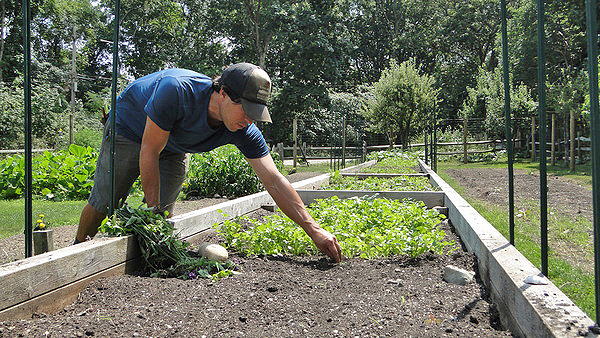
Green bean by green bean, Jeff Negron progressed through the garden behind Estia’s Little Kitchen in Sag Harbor one recent afternoon.
By row’s end, his hand was brimming with the long, slender beans and his mind, no doubt, was spinning with thoughts of what vegetables or weeds required attention next.
The 37-year-old gardener, who recently moved to Bridgehampton after several years in Sag Harbor, is, by his own account, “living the dream,” working at Bridge Gardens in Bridgehampton, as well as at two East End restaurant gardens, a third that is expected to open soon, and approximately a dozen private residential gardens.
In addition to harvesting and tending the parsley, cilantro, arugula, mesclun and mint at Estia’s, Mr. Negron also gardens at Nick & Toni’s in East Hampton, where red and green romaine lettuces, butterhead lettuce, carrots and kale reign supreme, and—once it opens—he will also apply his green thumb at Tom Colicchio’s Topping Rose House, now under construction in Bridgehampton.
“Every restaurant has different needs,” the busy gardener pointed out during an outdoor interview at Estia’s earlier this month during which his hands never stopped tending to the plant life. With a “Long Island Cauliflower Association” hat on his head, some gardening tools peeking out from his back pocket and his hands yanking out weeds, he explained that carrots, onions and tomatoes are the bread-and-butter basics of the gardens where he works.
There’s no kale at Estia’s, but Nick & Toni’s “eats it up,” he said. On the other hand, plenty of parsley sprouts forth at Estia’s, but the volume of the garden would not make sense for it to grow at Nick & Toni’s, he said.
As for Mr. Colicchio’s newest venture, he said that having Mr. Negron’s helping hand is a real benefit.
“We’re excited to have the farm in our own backyard and fortunate that we found a partner who not only understood what we were looking for, but also showed a deep commitment to organic farming,” Mr. Colicchio said via email.
Mr. Negron has also begun working with several local school gardens—including those in Sag Harbor, Springs and Southampton—having won one of three Joshua Levine Memorial Foundation grants to help turn kids’ attention to the salad bar. But it’s his work at the local eateries where he starts each day at about 6:30 a.m. and where the fresh fruits and veggies of his labor are served.
“My parents still shake their heads. They can’t believe I’m doing what I’m doing,” the gardener with a criminal justice degree from Northeastern University, said. “I used to terrorize the garden, knockin’ down lilies. I hated weeding and hated dividing plants. And low and behold, here I am, doing it all every single day.”
Though his expanded repertoire means it’s no longer economical or timely to ride his bike from garden to garden as he once did when all his gardening took place in Sag Harbor, he is still pleased with the rewards of his work.
“My mission statement has always been to connect smaller gardens to larger gardens,” he explained, pointing out that for each large garden he cares for, he also tends about three little gardens down the road.
His gardening for the restaurants is similar to that of home gardening, he said, but the major difference is knowing when to switch things up.
“I can get a better sense of when a crop needs to be rotated out, whereas a homeowner, for example, will grow that tomato no matter how sickly and diseased it is to the bitter end,” he said. “With some experience, and because we need to keep turning things over at the restaurant when there’s more of a demand, you need to be able to say, ‘Get it out and let’s get something else back in.’ That’s the major difference.”
Weeding all the while, Mr. Negron also shared some tips for home gardeners.
“If there’s anything of any help I can offer anybody that reads this, it’s that your crops are going to get tired and it’s important to know when to call it quits,” he said, citing the recent tomato blight as an example of knowing when to dispose of ill tomatoes.
Other advice he offered was to think small to reap greater rewards.
“You don’t need 100 square feet to feed a family of four. All you really need is about 30 square feet,” he said, adding that it is wise to use the gardening space effectively.
He also recommended always using flowering plants, such as chamomile, borage, nasturtium and calendula, to add easy visual appeal to the garden. “These are the bread and butter of beneficial annual plants that will self-seed themselves,” he said, noting that a one-time purchase will yield great dividends with the plants coming back year after year.
Color is another plus.
“They offer color, announcing to all the insects that there’s something happening here, which then attracts beneficial insects to your garden,” he said.
Finally, some of these plants can be used for different purposes. Calendula not only flowers, but is also edible, as is nasturtium. Chamomile can be used for tea and also for spraying tomatoes to help with disease problems, he said.
Last but not least, he recommended that potential gardeners talk to their neighbors and other fruit and vegetable farmers.
“Gardening, I think, encourages dialogue,” he said. “Visit your farmers market, ask questions. Ask different farmers their thoughts on different crops. There’s a lot of varieties of vegetables out there. It’s a lot of fun to look for them, to try out different varieties of tomato or eggplant. And sometimes you’ll be rewarded with a surprise.”